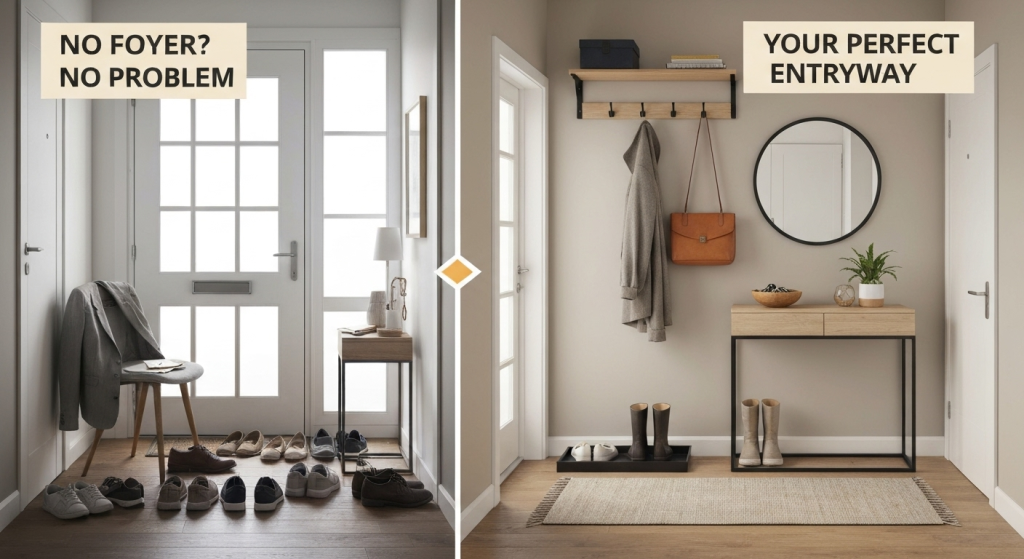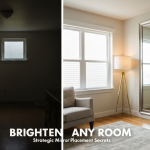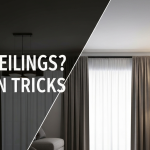Creating a functional entryway is one of the most common challenges I see in homes where the front door opens directly into the main living area. One minute you’re outside, and the next you’re in the middle of the living room, with no place to drop your keys, hang your coat, or kick off your shoes. This often leads to a pile of clutter that slowly creeps into your relaxation space, causing low-key stress and making the whole room feel disorganized. But here’s the good news: you don’t need a formal foyer to have a functional, welcoming entrance. You just need a bit of creativity and a clear plan.
For the past five years, my work has centered on helping people find simple, practical solutions for their homes. I’ve spent countless hours in spaces of all sizes, from tiny city apartments to sprawling open-plan houses, figuring out what truly works. My passion isn’t just about making things look pretty; it’s about understanding how a well-organized space can make daily life feel calmer and more intentional. Through exploring different layouts and listening to what people truly need, I’ve learned that the best solutions are often the simplest. This article is a collection of that experience, designed to give you clear, actionable ideas to reclaim your entrance.
Why a Designated Entryway Matters
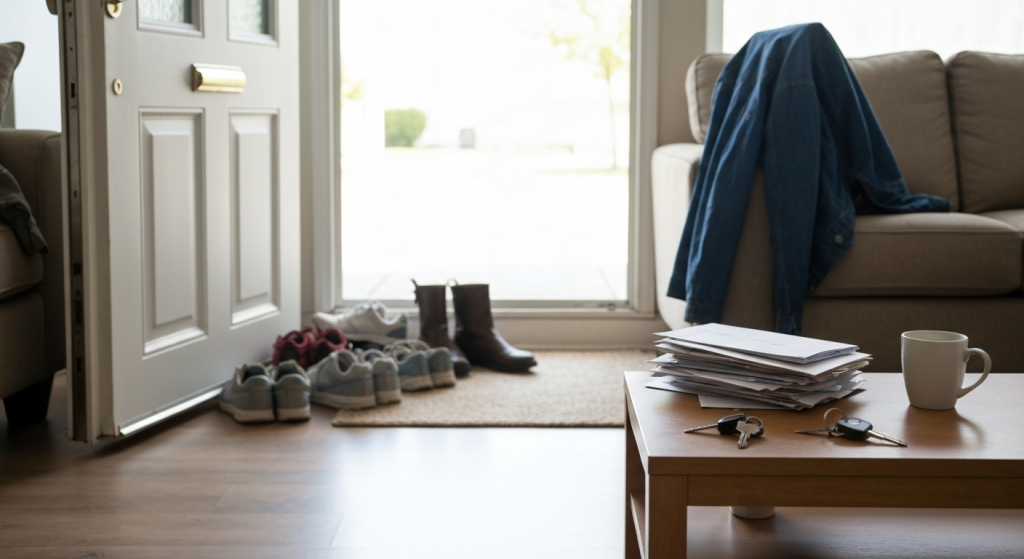
Before we dive into the “how,” let’s talk about the “why.” A designated entryway, even a small one, does more than just contain clutter. It serves a crucial psychological purpose.
- Creates a Transition Zone: It acts as a buffer between the outside world and the sanctuary of your home. This is the place where you can mentally and physically unload the day before stepping fully into your personal space.
- Sets the Tone: The entrance is the first impression your home makes on guests and on you every time you walk in the door. An organized entryway communicates a sense of calm and order.
- Boosts Efficiency: Knowing exactly where your keys, wallet, and sunglasses are saves you from frantic last-minute searches when you’re trying to leave the house. It streamlines your comings and goings.
The First Step: Visually Defining Your Entry Zone
The most important step in creating a faux entryway is to visually separate it from the rest of your living space. You need to trick the eye into seeing a distinct “zone.” This doesn’t require walls or major construction. In fact, you can do it with a few simple, strategic elements.
Use a Rug to Anchor the Space
A runner or a durable area rug is your best friend here. It literally draws a line on the floor, creating a visual boundary. When you step onto the rug, you’re in the “entryway.” When you step off it, you’re in the living room.
- Size Matters: Choose a size that feels proportional. It should be large enough to accommodate you standing and taking off your shoes, but not so large that it overwhelms the living area. A 2’x3′ or 3’x5′ rug often works well. For a longer, narrower space, a runner is perfect.
- Material is Key: This is a high-traffic area. Look for durable, easy-to-clean materials like jute, sisal, or low-pile wool. Indoor/outdoor rugs are also a fantastic, budget-friendly option because they can handle dirt and moisture.
The Power of Paint and Lighting
If you’re willing to make a slightly bigger commitment, you can use paint or lighting to define your zone.
- Create an Accent Wall: Painting the wall where your entryway furniture will live a different color—even a subtle shade darker or lighter than the rest of the room—instantly sets it apart.
- Add Dedicated Lighting: A stylish wall sconce or a small lamp on a console table gives the entryway its own light source. This makes it feel intentional and welcoming, especially when you come home after dark. It signals that this isn’t just a random wall; it’s a specific area with a specific purpose.
Core Furniture: The Building Blocks of Your Entryway
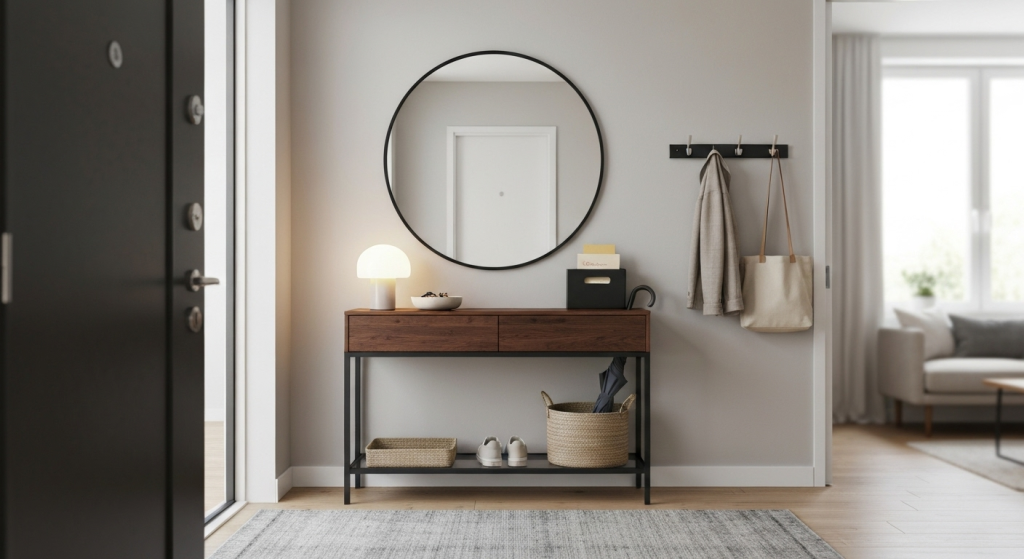
Once you’ve defined the space, it’s time to add function. The furniture you choose will depend entirely on your space and your needs. The key is to think slim, vertical, and multi-purpose.
The Slim Console Table: Your Entryway Workhorse
If you have the floor space (even just 10-12 inches of depth), a slim console table is the ultimate solution. It provides a “drop zone” surface without jutting too far into the room.
What to Look For:
- Depth: The most important factor. Look for tables under 15 inches deep. Some super-slim models are only 10 inches deep.
- Height: A standard table height (around 30 inches) is perfect.
- Open vs. Closed Storage: Tables with an open bottom shelf or “leggy” designs feel less bulky and allow you to tuck baskets or a shoe tray underneath. Models with drawers offer hidden storage for mail, chargers, and other small clutter.
| Furniture Type | Pros | Cons | Best For |
| Slim Console Table | Provides a surface and storage. Looks intentional and stylish. Lots of options available. | Requires some floor space. Can become a clutter magnet if not managed. | Homes with at least a foot of spare depth near the door. |
| Wall-Mounted Shelf | Takes up zero floor space. Minimalist and modern look. Very budget-friendly. | Limited weight capacity. No hidden storage. | Tiny apartments or extremely narrow spaces. |
| Storage Bench | Offers seating and storage in one. Great for hiding shoes or bags. Defines the space clearly. | Can be bulkier than a console table. Seating might be rarely used. | Families with kids or anyone who likes to sit while putting on shoes. |
How I’ve Seen it Work: In a client’s narrow apartment hallway, we used a 10-inch deep console table. On top, we placed a small ceramic bowl for keys and a slim lamp. Underneath, a low, wide basket held the two pairs of shoes they wore most often. It completely transformed the space from a cluttered walkway into a purposeful entry.
Wall-Mounted Solutions: Going Vertical in Tight Spaces
When floor space is non-existent, the only way to go is up. Using your walls is the secret to creating function out of thin air.
- Floating Shelves: A simple floating shelf can act as a mini console table. Install one at waist height to hold your keys, wallet, and a small plant. You can even install a couple of shelves vertically for more storage.
- Wall Hooks and Racks: Forget the bulky coat tree that gets knocked over. A sturdy wall-mounted coat rack or a few individual hooks provides a place for jackets, bags, and scarves without taking up an inch of the floor. For a clean look, choose hooks that match your door hardware.
- Slim Wall-Mounted Shoe Cabinets: These are a game-changer. Many are only about 6-8 inches deep and have tilt-out compartments that store several pairs of shoes vertically. They keep shoes completely out of sight.
The Mighty Bench: Seating and Storage in One
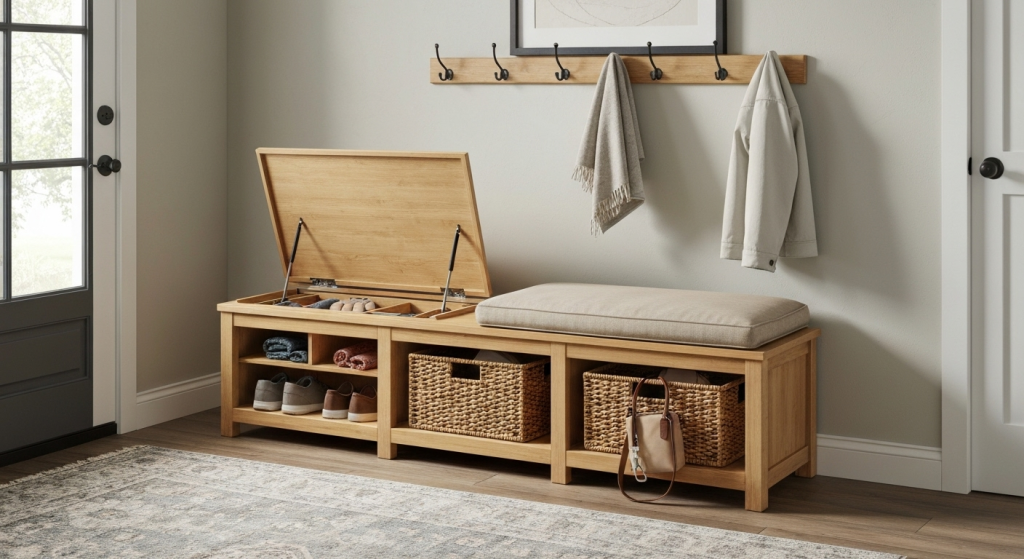
A small bench can be an incredibly versatile piece for an entryway. It clearly defines the zone and offers both a place to sit and a place to store things.
- The Storage Bench: Look for a bench where the top lifts to reveal a hidden compartment. This is perfect for stashing away items you don’t use daily, like winter hats, gloves, or reusable shopping bags.
- The Open Bench: A simple wooden or upholstered bench with open space underneath is perfect for sliding a few storage baskets. Assign one basket per family member or use them for different categories (one for shoes, one for sports gear).
Essential Accessories to Tie It All Together
The right accessories are what make your created entryway feel complete and truly functional. They handle the small details that make a big difference.
- A Mirror is a Must: A mirror is non-negotiable in a small entryway. It reflects light, making the space feel bigger and brighter. It’s also practical for that last-minute check before you head out the door. A large round mirror hung above a console table can act as a beautiful focal point.
- Trays and Bowls for Small Items: To prevent your console table or shelf from becoming a mess, use a small tray, bowl, or decorative box. This contains the clutter. Train yourself to always put your keys, wallet, and sunglasses in that one spot. It’s a simple habit that makes a world of difference.
- Baskets for Everything Else: Baskets are the ultimate clutter-busters. Use them on shelves, under benches, or right on the floor. They can hide shoes, umbrellas, pet leashes, and more. Woven baskets add warmth and texture to the space.
- A Boot Tray: If you live in a climate with rain or snow, a simple, waterproof boot tray is essential. Place it under your console table or next to your bench. It contains water, mud, and dirt, protecting your floors and keeping the mess contained.
Putting It Into Practice: Three Scenarios
Let’s break down how you can combine these elements based on your specific needs and space.
Scenario 1: The Tiny Apartment Entry
You have almost no space between your front door and your living room sofa.
- The Solution: Focus entirely on the wall.
- Install a wall-mounted hook rack for your coat and bag.
- Above it, hang a small floating shelf with a lip to prevent items from falling. Place a small bowl on it for your keys.
- Next to the door, place a durable, textured doormat for shoes.
- If you can, hang a small, frameless mirror on the wall to open up the space.
Scenario 2: The Busy Family Drop-Zone
You have a bit more room to work with, but you need to manage the clutter from multiple people.
- The Solution: Create a “command center.”
- Anchor the space with a sturdy, long console table.
- On top, place a mail sorter and a charging station for devices.
- Above the table, hang a combination corkboard/whiteboard for reminders and schedules.
- Underneath, use labeled bins or baskets for each family member’s shoes or gear.
- On the wall, install enough hooks for everyone’s most-used jacket and backpack.
Scenario 3: The Style-Conscious Minimalist
You want function, but aesthetics are just as important. Your home has a clean, modern feel.
- The Solution: Choose pieces that double as decor.
- Select a sleek console table with clean lines, perhaps in a metal or dark wood finish.
- Hang a large, oversized round mirror above it. This becomes the art for the space.
- Place a single, beautiful ceramic bowl on the table for keys. Add a small, sculptural lamp.
- Underneath, slide one large, structured woven basket for a pair of shoes or a bag. Keep everything else out of sight.
Troubleshooting Common Issues
Even with the best plan, you might run into a few hurdles. Here’s how to tackle them.
- “My entryway still feels cluttered.”
- This is usually a sign of having too much stuff, not a lack of organization. An entryway is for everyday items only. Store out-of-season coats, special occasion shoes, and extra bags elsewhere. Implement a one-in, one-out rule.
- “The furniture makes my living room feel smaller.”
- Opt for “leggy” furniture that you can see under, like a console table on tall, thin legs. This creates an illusion of more space. Also, use a large mirror to reflect the room and make it feel more expansive.
- “No one else in my house uses it.”
- Habit-forming takes time. Make it as easy as possible. Assign specific hooks and baskets to each person. Lead by example. For a few weeks, you may need to kindly remind your family to use the new system.
Frequently Asked Questions
How can I create an entryway with literally zero floor space?
Focus 100% on the wall. Use a combination of wall hooks for coats and bags, and a small wall-mounted shelf or a wall-mounted mail organizer with key hooks built-in. This keeps everything off the floor.
What is the best way to hide shoe clutter?
A slim, wall-mounted shoe cabinet is the most effective solution as it completely conceals them. Alternatively, a storage bench with a lift-up top or deep baskets tucked under a console table works wonders.
Should my entryway rug match my living room rug?
They don’t need to match, but they should coordinate. Choose a rug for the entryway that shares a similar color palette or style with your main living room rug. A durable, natural fiber rug like jute often complements many different styles.
What kind of lighting is best for a created entryway?
Soft, warm lighting is ideal. A small table lamp with a lampshade on a console table creates a cozy, welcoming glow. If you have no room for a table, a plug-in wall sconce is a fantastic option that adds a touch of sophistication.
Conclusion: Your Home Starts at the Door
Creating a functional entryway when you don’t have one is entirely possible. It’s not about having the perfect architecture; it’s about being intentional with the space you have. By using a rug to define the zone, choosing slim, multi-purpose furniture, and adding smart accessories, you can carve out a welcoming and organized entrance that works for you. Start small, focus on your biggest clutter pain points, and build from there. You’ll be amazed at how a well-designed drop-zone can bring a sense of peace and order to your entire home, starting the moment you walk through the door.
